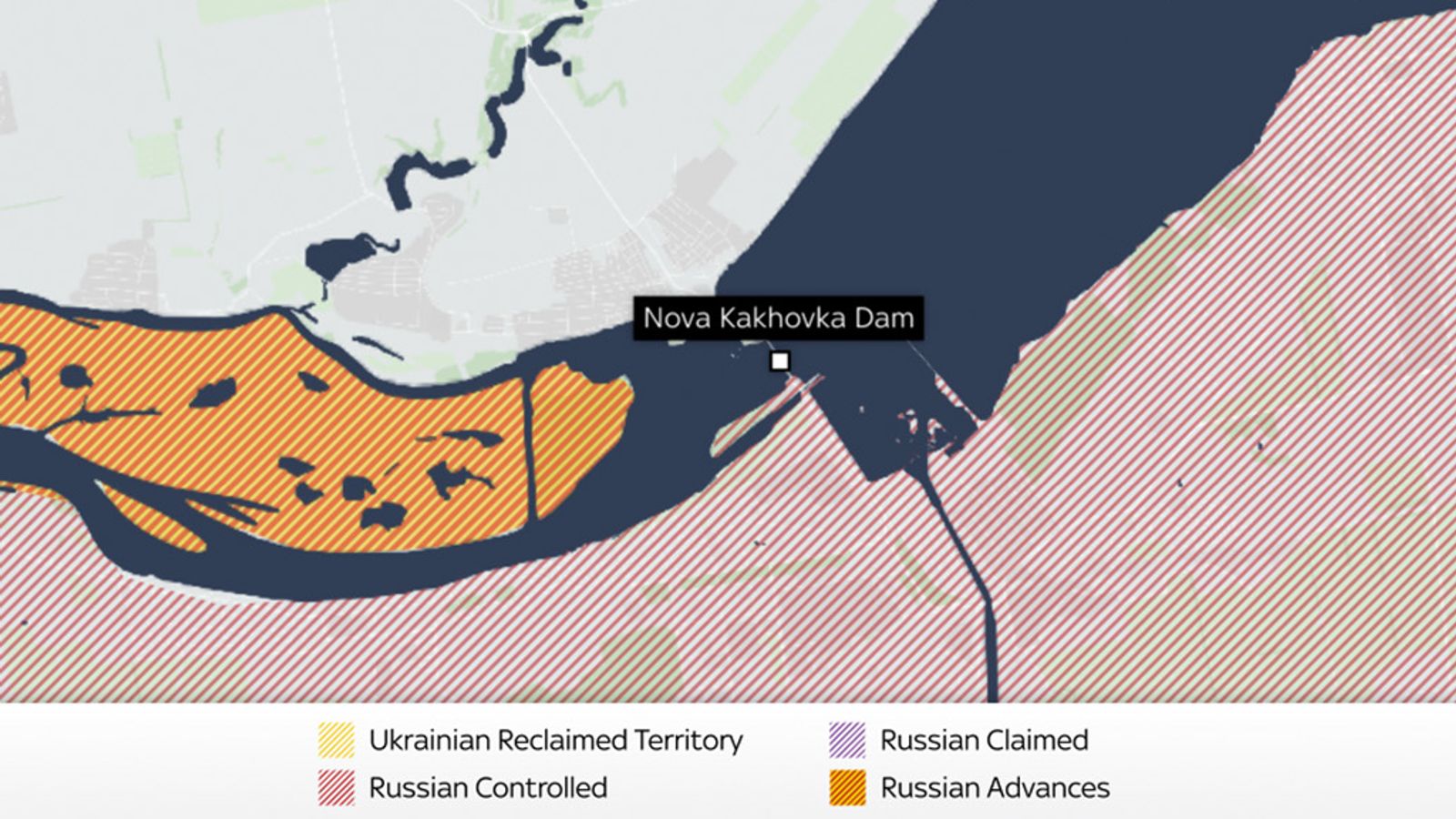Analysis
Ukraine war: Explosives most likely cause of dam collapse, experts say
The collapse of the Khakovka dam devastated parts of southern Ukraine, leaving thousands displaced and without access to drinking water. Who was behind it remains unconfirmed – but experts now tell Sky News the disaster was likely caused by explosives.
By Victoria Elms, digital investigations journalist and Adam Parker, OSINT desk editor
Thursday 8 June 2023 22:30, UK
Listen to this article
0:00 / 6:58
1X
BeyondWords
Audio created using AI assistance
Tens of vehicles can be seen lined up next to the dam on the Russian-controlled side of the river in February. Credit: Maxar2:38
Play Video – What dam explosion evidence proves
Can evidence prove who shelled the dam?
Why you can trust Sky News
Explosives are the most likely cause for the collapse of the enormous Kakhovka Dam, experts have told Sky News, days after its breach caused catastrophic flooding in towns and villages.
Both Ukraine and Russia continue to blame one another for the dam’s destruction, which has left thousands displaced and without access to drinking water.
For months, Russia and Ukraine have accused each other of plotting to bring down the two-mile-long structure, an integral part of southern Ukraine’s infrastructure which straddles the river dividing Ukrainian-held Kherson from Russian-controlled territory.
Who bears responsibility for the incident remains unclear. But based on the available evidence, experts now say a co-ordinated explosion is the most likely explanation for its collapse.
The Russian-controlled dam runs across Ukraine's enormous Dnieper river, which divides Russian-occupied and Ukrainian-held Kherson.
Image:
The Russian-controlled dam runs across Ukraine’s enormous Dnieper river, which divides Russian-occupied and Ukrainian-held Kherson
What happened?
Exactly when the incident occurred on Tuesday morning is not clear, but several differing reports indicate that it began after 2am.
On local Telegram groups, residents reported hearing what sounded like explosions at around 2.20am.
Twenty minutes later, residents using the same group chat reported hearing loud rushing water.
“It didn’t make this noise before the explosions,” one user said.
The Norwegian research agency NORSAR, which monitors seismic events, said its station in the region picked up a signal at 2.54am local time. This signal, it says, indicates there was an explosion.
NORSAR's post over 385 miles away in Romania picked up the signal. The time on the chart relates to Norway's timezone, which is an hour behind Ukraine. Credit: NORSAR
Image:
NORSAR’s post over 385 miles away in Romania picked up the signal. The time on the chart relates to Norway’s timezone, which is an hour behind Ukraine. Credit: NORSAR
Just two days before, satellite imagery shows part of the road running over the top of the spillway had been severely damaged. It’s not known what caused this, and the flow of water does not at this stage appear to have been affected.
Move the marker below to see the road on June 1 compared to June 2.
The earliest visual evidence of the dam’s breach that Sky News has seen was captured sometime between 2.20am and 5am on June 6.
We know it’s the dam because the pylon on the right-hand side of the shot matches with separate images of the hydroelectric power plant. But the footage is grainy, and its authenticity is difficult to fully confirm.
The pylon was situated on the spillway close to the river's southern bank, which is controlled by Russia.
Image:
The pylon was situated on the spillway close to the river’s southern bank, which is controlled by Russia
In the footage, we can see water rushing over a partially damaged part of the dam.
Sky News believes around 200 metres of the spillway has been breached at the time this was captured.
Eight seconds into the clip, we see what appears to be an explosion close to the remaining spillway.
X
The blast does not have a visible impact on the remaining structure – but demonstrates the kind of destructive activity that appears to have been going on in the area around the time of the breach.
Another clip taken from the air and shared by Ukrainian officials shows the scene around two hours later. An excerpt of the two-and-a-half-minute-long video can be viewed below.
The dam appears to have sustained more damage since the first video. Sky News estimates around 250 metres of the spillway had been breached when this was captured – and the pylon we saw in the previous clip is no longer there.
We also see the full extent of the damage to the dam for the first time; two parts of the spillway’s middle section are gone, with two structures remaining in between.
This is most clear in satellite imagery captured by Planet.
What caused it?
“Looking at the footage, satellite imagery and videos taken, it’s clear cut that some sort of explosive device damaged the dam,” said Dr Kiran Tota-Maharaj, Reader in Civil and Environmental Engineering at Aston University Birmingham.
“In dam construction, the risks to a dam’s failure are natural disasters like seismic events or heavy rainfall. But we have not had any of that in Ukraine, so it’s clear that some sort of man-made application on the reinforced concrete section must have caused it,” he told Sky News.
The water levels in the dam’s adjoining reservoir were at the highest level they’ve ever been in the lead-up to the incident. It was initially thought that this could have contributed towards the dam’s collapse.
However, Dr Tota-Maharaj says pre-war pictures of the dam seem to show the authorities had maintained it well, making this unlikely.
The dam is made of reinforced concrete in the central area.
Image:
The dam is made of reinforced concrete in the central area
Russia and Ukraine have for months accused one another of plotting to destroy the structure, which has been under the control of occupying Russian forces since they captured Kherson in the war’s early phases.
In October last year, Ukrainian officials accused Russia of planting explosives inside the structure as far back as April – which is what they say was behind Tuesday’s disaster.
The dam, however, has sustained damage in shelling before.
In November, one of its floodgates was damaged by a shell in what a Ukrainian general told the Washington Post was a “test” hit to explore options for the counteroffensive Ukraine was mounting in the area.
Russian officials now say Ukraine used these same methods on Tuesday to destroy the dam entirely.
Colonel Hamish de Bretton-Gordon, a munitions expert and former army officer, believes this to be implausible.
“If it is true that the Ukrainians fired a HIMAR in November and took out one gate, they would have needed to fire 20-30 HIMARs to cause the damage we see here. But nobody is reporting that, there is no evidence to suggest that happened,” he told Sky News.
“In order to create this much devastation, it must have been a very sophisticated bunch of explosives put in the right places. It was enough, and calculated enough, to destroy the whole dam.”
Without an independent investigation, it’s unlikely that a full explanation for the dam’s collapse will materialise anytime soon.
Meanwhile, Ukrainian authorities have issued warnings to the thousands of civilians living in the surrounding areas to be cautious of floating ordnance which has been washed by the floods from the battlefields upstream into residential areas.
The Data and Forensics team is a multi-skilled unit dedicated to providing transparent journalism from Sky News. We gather, analyse and visualise data to tell data-driven stories. We combine traditional reporting skills with advanced analysis of satellite images, social media and other open source information. Through multimedia storytelling we aim to better explain the world while also showing how our journalism is done.
Why data journalism matters to Sky News
Related Topics
Data And Forensics






























